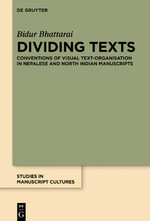SMC 10

Dividing Texts:
Conventions of Visual Text-Organisation in Nepalese and North Indian Manuscripts
By Bidur Bhattarai
The number of manuscripts produced in the Indian sub-continent is astounding and is the result of a massive enterprise that was carried out over a vast geographical area and over a vast stretch of time. Focusing mainly on areas of Northern India and Nepal between 800 to 1300 CE and on manuscripts containing Sanskrit texts, the present study investigates a fundamental and so far rarely studied aspect of manuscript production: visual organisation.
Scribes adopted a variety of visual strategies to distinguish one text from another and to differentiate the various sections within a single text (chapters, sub-chapters, etc.). Their repertoire includes the use of space(s) on the folio, the adoption of different writing styles, the inclusion of symbols of various kind, the application of colours (‘rubrication’), or a combination of all these.
This study includes a description of these various strategies and an analysis of their different implementations across the selected geographical areas. It sheds light on how manuscripts were produced, as well as on some aspects of their employment in ritual contexts, in different areas of India and Nepal.
FrontmatterI
ContentsV
PrefaceIX
AcknowledgementsX
1. Introduction1
2. Overall layout and possible reasons for its change in manuscript42
3. Use of symbols75
4. Use of space233
5. Use of colour262
6. Conclusions301
Appendices305
References357
List of Figures363
Index of Manuscripts373
